Related Research Articles
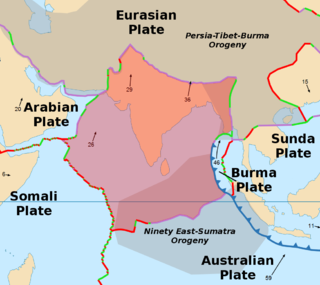
The Indian plate is a minor tectonic plate straddling the equator in the Eastern Hemisphere. Originally a part of the ancient continent of Gondwana, the Indian plate broke away from the other fragments of Gondwana 100 million years ago and began moving north, carrying Insular India with it. It was once fused with the adjacent Australian plate to form a single Indo-Australian plate; recent studies suggest that India and Australia have been separate plates for at least 3 million years. The Indian plate includes most of modern South Asia and a portion of the basin under the Indian Ocean, including parts of South China, western Indonesia, and extending up to but not including Ladakh, Kohistan, and Balochistan in Pakistan.
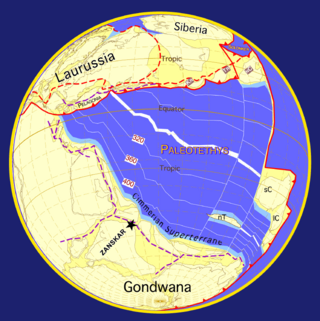
The geology of the Himalayas is a record of the most dramatic and visible creations of the immense mountain range formed by plate tectonic forces and sculpted by weathering and erosion. The Himalayas, which stretch over 2400 km between the Namcha Barwa syntaxis at the eastern end of the mountain range and the Nanga Parbat syntaxis at the western end, are the result of an ongoing orogeny — the collision of the continental crust of two tectonic plates, namely, the Indian Plate thrusting into the Eurasian Plate. The Himalaya-Tibet region supplies fresh water for more than one-fifth of the world population, and accounts for a quarter of the global sedimentary budget. Topographically, the belt has many superlatives: the highest rate of uplift, the highest relief, among the highest erosion rates at 2–12 mm/yr, the source of some of the greatest rivers and the highest concentration of glaciers outside of the polar regions. This last feature earned the Himalaya its name, originating from the Sanskrit for "the abode of the snow".

The geology of Nepal is dominated by the Himalaya, the highest, youngest and a very highly active mountain range. Himalaya is a type locality for the study of on-going continent-continent collision tectonics. The Himalayan arc extends about 2,400 km (1,500 mi) from Nanga Parbat by the Indus River in northern Pakistan eastward to Namche Barwa by the gorge of the Tsangpo-Brahmaputra in eastern Tibet. About 800 km (500 mi) of this extent is in Nepal; the remainder includes Bhutan and parts of Pakistan, India, and China.
The 1905 Kangra earthquake occurred in the Kangra Valley and the Kangra district of the Himachal Pradesh, in India on 4 April 1905. The earthquake measured 7.8 on the surface-wave magnitude scale and killed more than 20,000 people. Apart from this, most buildings in the towns of Kangra, Mcleodganj and Dharamshala were destroyed. The earthquake also had a widespread impact in Jammu and Kashmir particularly in the densely populated Kashmir valley. A total of 7,000 to 8,000 people were killed in Jammu and Kashmir with 4,000 to 5,000 deaths occurring in the Kashmir valley. Widespread structural damage was reported across Himachal Pradesh, Jammu and Kashmir and Uttrakhand.
The 1991 Uttarkashi earthquake occurred at 02:53:16 Indian Standard Time (UTC+05:30) on 20 October with a moment magnitude of 6.8 and a maximum Mercalli intensity of IX (Violent). This thrust event was instrumentally recorded and occurred along the Main Central Thrust in the Uttarkashi and Gharwal regions of the Indian state of Uttarakhand. High intensity shaking resulted in the deaths of at least 768 people and the destruction of thousands of homes.
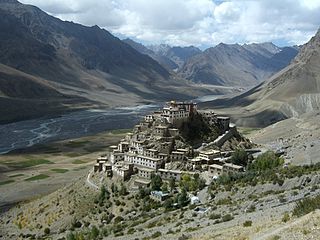
The 1975 Kinnaur earthquake occurred in the early afternoon of 19 January. It had a magnitude of 6.8 on the surface-wave magnitude scale and a maximum perceived intensity of IX (Violent) on the Mercalli intensity scale, causing extensive damage in Himachal Pradesh, in northern India. Its epicentre was in Kinnaur district in the southeastern part of Himachal Pradesh and caused 47 casualties. Landslides, rock falls and avalanches caused major damage to the Hindustan-Tibet Road. The earthquake affected many monasteries and buildings in the state and led to an extensive restoration work in the late 1970s and early 1980s in Himachal Pradesh. The Spiti and Parachu valleys in particular suffered the greatest damage being on the north–south Kaurik-Chango fault, causing damage to landmarks such as Key Monastery and Tabo Monastery.

The South Tibetan Detachment is one of the major faults in the Himalaya Mountains.
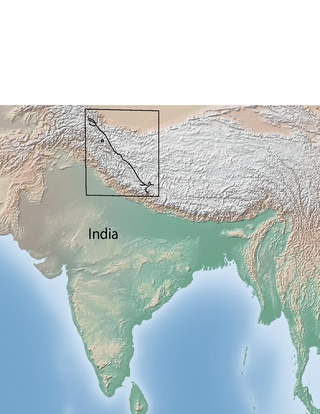
The Karakoram fault is an oblique-slip fault system in the Himalayan region across India and Asia. The slip along the fault accommodates radial expansion of the Himalayan arc, northward indentation of the Pamir Mountains, and eastward lateral extrusion of the Tibetan plateau. Current plate motions suggest that the convergence between the Indian plate and the Eurasian plate is around 44±5 mm per year in the western Himalaya-Pamir region and approximately 50±2 mm per year in the eastern Himalayan region.

The Main Central Thrust is a major geological fault where the Indian plate has pushed under the Eurasian plate along the Himalaya. The fault slopes down to the north and is exposed on the surface in a NW-SE direction (strike). It is a thrust fault that continues along 2900 km of the Himalaya mountain belt.

The Himalayan foreland basin is an active collisional foreland basin system in South Asia. Uplift and loading of the Eurasian Plate on to the Indian Plate resulted in the flexure (bending) of the Indian Plate, and the creation of a depression adjacent to the Himalayan mountain belt. This depression was filled with sediment eroded from the Himalaya, that lithified and produced a sedimentary basin ~3 to >7 km deep. The foreland basin spans approximately 2,000 kilometres (1,200 mi) in length and 450 kilometres (280 mi) in width. From west to east the foreland basin stretches across five countries: Pakistan, India, Nepal, Bangladesh, and Bhutan.
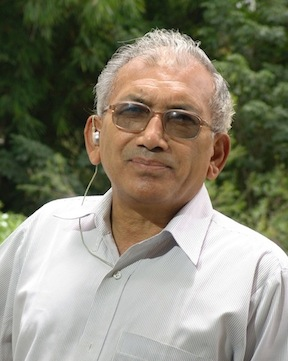
Khadg Singh Valdiya was an Indian geologist and a former vice chancellor of Kumaon University, internationally recognized for his path-breaking work in the fields of geodynamics and Environmental Science. A 2007 recipient of Padma Shri, he was honoured again by the Government of India in 2015 with Padma Bhushan, the third highest Indian civilian award.

Pre-collisional Himalaya is the arrangement of the Himalayan rock units before mountain-building processes resulted in the collision of Asia and India. The collision began in the Cenozoic and it is a type locality of a continental-continental collision. The reconstruction of the initial configuration of the rock units and the relationship between them is highly controversial, and major concerns relate to the arrangements of the different rock units in three dimensions. Several models have been advanced to explain the possible arrangements and petrogenesis of the rock units.
One of the major depositional strata in the Himalaya is the Lesser Himalayan Strata from the Paleozoic to Mesozoic eras. It had a quite different marine succession during the Paleozoic, as most parts of it are sparsely fossiliferous or even devoid of any well-defined fossils. Moreover, it consists of many varied lithofacies, making correlation work more difficult. This article describes the major formations of the Paleozoic – Mesozoic Lesser Himalayan Strata, including the Tal Formation, Gondwana Strata, Singtali Formation and Subathu Formation.

The geology of Himachal Pradesh is dominated by Precambrian rocks that were assembled and deformed during the India-Asia collision and the subsequent Himalayan orogeny. The Northern Indian State Himachal Pradesh is located in the Western Himalaya. It has a rugged terrain, with elevation ranging from 320m to 6975m. Rock materials in the region are largely from the Indian craton, and their ages range from the Paleoproterozoic to the present day. It is generally agreed that the Indian craton collided with Asia 50-60 million years ago (Ma). Rock sequences were thrust and folded immensely during the collision. The area has also been shaped by focused orographic precipitation, glaciation and rapid erosion.
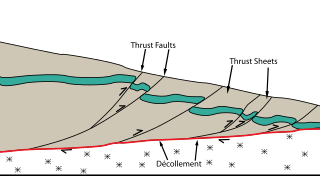
The Main Himalayan Thrust (MHT) is a décollement under the Himalaya Range. This thrust fault follows a NW-SE strike, reminiscent of an arc, and gently dips about 10 degrees towards the north, beneath the region. It is the largest active continental megathrust fault in the world.

The Main Frontal Thrust (MFT), also known as the Himalayan Frontal Thrust (HFT), is a geological fault in the Himalayas that defines the boundary between the Himalayan foothills and Indo-Gangetic Plain. The fault is well expressed on the surface thus could be seen via satellite imagery. It is the youngest and southernmost thrust structure in the Himalaya deformation front. It is a splay branch of the Main Himalayan Thrust (MHT) as the root décollement.
The 1555 Kashmir earthquake occurred at around midnight in the month of Ashvin in the Hindu calendar, or September in the Gregorian calendar, although the exact day of occurrence is not known. The earthquake seriously impacted the Kashmir Valley in present-day Pakistan and northwestern India. A moment magnitude (Mw ) of 7.6 to 8.0 and Modified Mercalli intensity of XII (Extreme) has been estimated for the earthquake. Thought to be one of the most destructive in the Kashmir Valley, the earthquake caused serious widespread damage and ground effects, killing an estimated 600–60,000 individuals.
The 1992 Kohat earthquake struck Khyber Pakhtunkhwa Province in Pakistan on May 20. The Mw 6.3 earthquake inflicted significant damage in the nearby city Kohat. An estimated 36 people died and 100 were injured in the Peshawar and Kohat districts. Four-hundred (400) homes were wiped out, affecting 2,100 residents in the region.
The 1980 Nepal earthquake devastated the Nepal–India border region on the evening of July 29. The epicenter of the 6.6 Mw earthquake was located in Nepal, northwest of Khaptad National Park. At least 200 people died and 5,600 were injured in the disaster. Extensive damage occurred on both sides of the border, amounting to 245 million USD.
References
- ↑ Meigs, Burbank & Beck 1995, p. 423, 425.
- ↑ Thiede et al. 2017, p. 716, 717.
- ↑ Meigs, Burbank & Beck 1995, p. 423.
- ↑ Patra & Saha 2019.
- 1 2 Valdiya 1980, p. 329.
- ↑ Valdiya 1980, p. 329, 331.
- ↑ Malinconico, Lillie & Nakata 1989, p. 253-254.
- ↑ Mugnier et al. 1994, p. 200; Malinconico, Lillie & Nakata 1989, p. 253.
- ↑ Malinconico, Lillie & Nakata 1989, p. 256.
- ↑ Riesner, Bollinger & Hubbard 2021.
- ↑ Valdiya 1980, p. 329, 334.
- ↑ Mugnier et al. 1994, p. 205, 210.
Sources
- Meigs, Andrew J.; Burbank, Douglas W.; Beck, Richard A. (May 1, 1995). "Middle-late Miocene (>10 Ma) formation of the Main Boundary thrust in the western Himalaya". Geology. 23 (5): 423–426. Bibcode:1995Geo....23..423M. doi:10.1130/0091-7613(1995)023<0423:MLMMFO>2.3.CO;2 . Retrieved 15 May 2024.
- Malinconico, Lawrence L. Jr.; Lillie, Robert J.; Nakata, Takashi (January 1, 1989). "Active faults of the Himalaya of India and Nepal". Tectonics of the western Himalayas. Vol. 232. Geological Society of America. pp. 243–264. doi:10.1130/SPE232-p243. ISBN 9780813722320 . Retrieved 24 May 2024.
- Mugnier, Jean-Louis; Huyghe, Pascale; Chalaron, Edouard; Mascle, Georges (15 November 1994). "Recent movements along the Main Boundary Thrust of the Himalayas: Normal faulting in an over-critical thrust wedge?". Tectonophysics. 238 (1–4): 199–215. Bibcode:1994Tectp.238..199M. doi:10.1016/0040-1951(94)90056-6 . Retrieved 24 May 2024.
- Patra, Abhijit; Saha, Dilip (March 2019). "Stress regime changes in the Main Boundary Thrust zone, Eastern Himalaya, decoded from fault-slip analysis". Journal of Structural Geology. 120: 29–47. Bibcode:2019JSG...120...29P. doi:10.1016/j.jsg.2018.12.010 . Retrieved 20 May 2024.
- Riesner, M.; Bollinger, L.; Hubbard, J. (2 November 2021). "Localized extension in megathrust hanging wall following great earthquakes in western Nepal". Scientific Reports. 11 (21521): 21521. Bibcode:2021NatSR..1121521R. doi:10.1038/s41598-021-00297-4. PMC 8563945 . PMID 34728644.
- Thiede, Rasmus; Robert, Xavier; Stübner, Konstanze; Dey, Saptarshi; Faruhn, Johannes (July 14, 2017). "Sustained out-of-sequence shortening along a tectonically active segment of the Main Boundary thrust: The Dhauladhar Range in the northwestern Himalaya". Lithosphere. 9 (5): 715–725. Bibcode:2017Lsphe...9..715T. doi:10.1130/L630.1 . Retrieved 15 May 2024.
- Valdiya, K. S. (10 July 1980). "The two intracrustal boundary thrusts of the Himalaya". Tectonophysics. 66 (4): 323–348. Bibcode:1980Tectp..66..323V. doi:10.1016/0040-1951(80)90248-6 . Retrieved 5 June 2024.